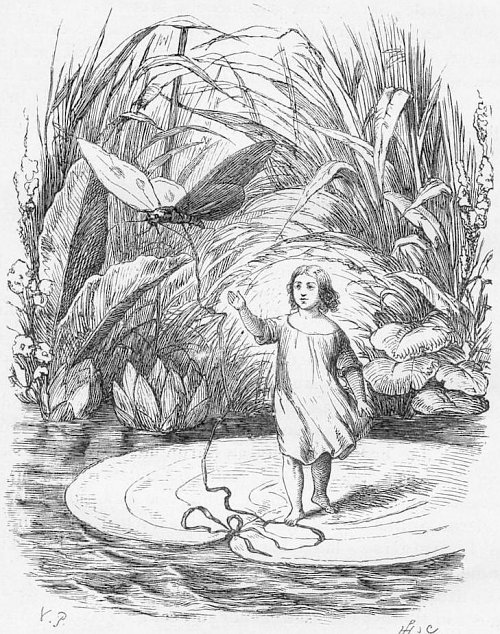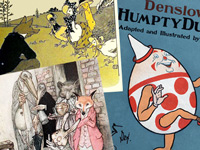Thumbelina

"Thumbelina" (Danish: Tommelise) is a literary fairy tale by Hans Christian Andersen first published by C. A. Reitzel on 16 December 1835 in Copenhagen, Denmark with "The Naughty Boy" and "The Traveling Companion" in the second installment of Fairy Tales Told for Children. "Thumbelina" is about a tiny girl and her adventures with appearance and marriage-minded toads, moles, and cockchafers. She successfully avoids their intentions before falling in love with a flower-fairy prince just her size.
"Thumbelina" is chiefly Andersen's invention, though he did take inspiration from tales of miniature people such as "Tom Thumb". "Thumbelina" was published as one of a series of seven fairy tales in 1835 which were not well received by the Danish critics who disliked their informal style and their lack of morals. One critic, however, applauded "Thumbelina". The earliest English translation of "Thumbelina" is dated 1846. The tale has been adapted to various media including television drama and animated film.
Plot
In the first English translation of 1847 by Mary Howitt, the tale opens with a beggar woman giving a peasant's wife a barleycorn in exchange for food. Once planted, a tiny girl, Thumbelina (Tommelise), emerges from its flower. One night, Thumbelina, asleep in her walnut-shell cradle, is carried off by a toad who wants the miniature maiden as a bride for her son. With the help of friendly fish and a butterfly, Thumbelina escapes the toad and her son, and drifts on a lily pad until captured by a stag beetle who later discards her when his friends reject her company.
Thumbelina tries to protect herself from the elements, but when winter comes, she is in desperate straits. She is finally given shelter by an old field mouse and tends her dwelling in gratitude. The mouse suggests Thumbelina marry her neighbor, a mole, but Thumbelina finds repulsive the prospect of being married to such a creature because he spent all his days underground and never saw the sun or sky. The field mouse keeps pushing Thumbelina into the marriage, saying the mole is a good match for her, and does not listen to her protests.
At the last minute, Thumbelina escapes the situation by fleeing to a far land with a swallow she nursed back to health during the winter. In a sunny field of flowers, Thumbelina meets a tiny flower-fairy prince just her size and to her liking, and they wed. She receives a pair of wings to accompany her husband on his travels from flower to flower, and a new name, Maia.
In Hans Christian Andersen's version of the story, a bluebird had been viewing Thumbelina's story since the beginning and had been in love with her since. In the end, the bird is heartbroken once Thumbelina marries the flower-fairy prince, and flies off eventually arriving at a small house. There, he tells Thumbelina's story to a man who is implied to be Andersen himself and chronicles the story in a book.
Background
Hans Christian Andersen was born in Odense, Denmark on 2 April 1805 to Hans Andersen, a shoemaker, and Anne Marie Andersdatter. An only and a spoiled child, Andersen shared a love of literature with his father who read him The Arabian Nights and the fables of Jean de la Fontaine. Together, they constructed panoramas, pop-up pictures, and toy theatres, and took long jaunts into the countryside.
Andersen's father died in 1816, and from then on, Andersen was left to his own devices. In order to escape his poor, illiterate mother, he promoted his artistic inclinations and courted the cultured middle class of Odense, singing and reciting in their drawing-rooms. On 4 September 1819, the fourteen-year-old Andersen left Odense for Copenhagen with the few savings he had acquired from his performances, a letter of reference to the ballerina Madame Schall, and youthful dreams and intentions of becoming a poet or an actor.
After three years of rejections and disappointments, he finally found a patron in Jonas Collin, the director of the Royal Theatre, who, believing in the boy's potential, secured funds from the king to send Andersen to a grammar school in Slagelse, a provincial town in west Zealand, with the expectation that the boy would continue his education at Copenhagen University at the appropriate time.
At Slagelse, Andersen fell under the tutelage of Simon Meisling, a short, stout, balding thirty-five-year-old classicist and translator of Virgil's Aeneid. Andersen was not the quickest student in the class and was given generous doses of Meisling's contempt. "You're a stupid boy who will never make it," Meisling told him. Meisling is believed to be the model for the learned mole in "Thumbelina".
Fairy tale and folklorists Iona and Peter Opie have proposed the tale as a "distant tribute" to Andersen's confidante, Henriette Wulff, the small, frail, hunchbacked daughter of the Danish translator of Shakespeare who loved Andersen as Thumbelina loves the swallow; however, no written evidence exists to support the theory.
LITERATURE FAIRY TALES

Thumbelina: Illustration by Vilhelm Pedersen, Andersen's first illustrator

Thumbelina: Illustration by Vilhelm Pedersen, Andersen's first illustrator
( Click image to enlarge)
A fairy tale is a type of short story that typically features folkloric fantasy characters, such as dwarves, elves, fairies, giants, gnomes, goblins, mermaids, trolls, or witches, and usually magic or enchantments. Fairy tales may be distinguished from other folk narratives such as legends (which generally involve belief in the veracity of the events described) and explicitly moral tales, including beast fables. The term is mainly used for stories with origins in European tradition and, at least in recent centuries, mostly relates to children's literature.
Read More » List of Fairy tales »
RESOURCES
This article uses material from the Wikipedia articles "List of fairy tales", "Fairy tale" and "Thumbelina", which is released under the Creative Commons Attribution-Share-Alike License 3.0.
© Stories Preschool. All Rights Reserved.





